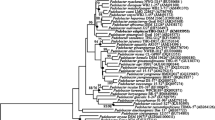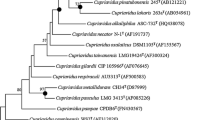Abstract
A novel strain, DCY108T was isolated from soil of a Panax ginseng field, Yeoncheon province (38°04′N 126°57′E), Republic of Korea. Strain DCY108T is Gram-negative, non-motile, non-flagellate, rod-shaped, and aerobic. The bacterium grows optimally at 25–30 °C, pH 6.5–7.0 and 1 % NaCl. Phylogenetically, strain DCY108T is closely related to Pedobacter jejuensis JCM 18824T, Pedobacter aquatilis JCM 13454T, Pedobacter kyungheensis LMG 26577T and the type strain of the genus Pedobacter heparinus DSM 2366T. The DNA–DNA relatedness values between strain DCY108T and its close phylogenetic neighbors were below 30.0 %. The DNA G+C content of strain DCY108T was determined to be 45.1 mol%. The predominant quinone was menaquinone 7 (MK-7). The major polar lipids were identified as phosphatidylethanolamine and three unidentified aminolipids AL1, AL13 and AL17. Iso-C15:00, iso-C17:03OH and summed feature 3 (C16:1 ω7c/C16:1 ω6c) were identified as the major fatty acids present in strain DCY108T. The results of physiological and biochemical tests allowed strain DCY108T to be differentiated phenotypically from other recognized species belonging to the genus Pedobacter. Therefore, it is suggested that the newly isolated organism represents a novel species, for which the name Pedobacter panacis sp. nov is proposed with the type strain designated as DCY108T (=CCTCCAB 2015196T = KCTC 42748T).

Similar content being viewed by others
References
Anzai Y, Kim H, Park JY, Wakabayashi H, Oyaizu H (2000) Phylogenetic affiliation of the Pseudomonas based on 16S rRNA sequence. Int J Syst Evol Microbiol 50:1563–1589
Bauer AW, Kirby WM, Sherris JC, Turck M (1966) Antibiotic susceptibility testing by a standardized single disk method. Am J Clin Path 45:493–496
Bernardet JF, Nakagawa Y, Holmes B (2002) Subcommittee on the taxonomy of Flavobacterium & Cytophaga-like bacteria of the International Committee on Systematics of Prokaryotes. Proposed minimal standards for describing new taxa of the family Flavobacteriaceae and emended description of the family. Int J Syst Evol Microbiol 52:1049–1070
Cho KM, Hong SY, Lee SM, Kim YH, Kahng GG, Lim YP, Kim H, Yun HD (2007) Endophytic bacterial communities in ginseng and their antifungal activity against pathogens. Microb Ecol 54(2):341–351
Christensen WB (1946) Urea decomposition as a means of differentiating proteus and paracolon cultures from each other and from Salmonella and Shigella types. J Bacteriol 52:461–466
Collins MD (1985) Isoprenoid quinone analyses in bacterial classification and identification. In: Goodfellow M, Minnikin DE (eds) Chemical methods in bacterial systematics. Academic Press, London, pp 267–287
Cowan ST, Steel KJ (1974) Manual for the identification of medical bacteria, 3rd edn. Cambridge University Press, Cambridge
Du J, Singh H, Ngo HT, Won KH, Kim KY, Yi TH (2015) Pedobacter daejeonensis sp. nov. and Pedobacter trunci sp. nov., isolated from an ancient tree trunk, and emended description of the genus Pedobacter. Int J Syst Evol Microbiol 65:1241–1246
Ezaki T, Hashimoto Y, Yabuuchi E (1989) Fluorometric deoxyribonucleic acid-deoxyribonucleic acid hybridization in microdilution wells as an alternative to membrane filter hybridization in which radioisotopes are used to determine genetic relatedness among bacterial strains. Int J Syst Evol Microbiol 39:224–229
Farh MEA, Kim YJ, Van An H, Sukweenadhi J, Singh P, Huq MA, Yang DC (2015) Burkholderia ginsengiterrae sp. nov. and Burkholderia panaciterrae sp. nov., antagonistic bacteria against root rot pathogen Cylindrocarpon destructans, isolated from ginseng soil. Arch Microbiol 197(3):439–447
Felsenstein J (1981) Evolutionary trees from DNA sequences: a maximum likelihood approach. J Mol Evol 17:368–376
Felsenstein J (1985) Confidence limits on phylogenies: an approach using the bootstrap. Evolution 39:783–791
Fitch WM (1971) Toward defining the course of evolution: minimum change for a specific tree topology. Syst Zool 20:406–416
Gallego V, García MT, Ventosa A (2006) Pedobacter aquatilis sp. nov., isolated from drinking water, and emended description of the genus Pedobacter. Int J Syst Evol Microbiol 56:1853–1858
Hall TA (1999) BioEdit: a user-friendly biological sequence alignment editor and analysis program for windows 95/98/NT. Nucleic Acids Symp Ser 41:95–98
Huq MA, Kim YJ, Hoang VA, Siddiqi MZ, Yang DC (2015) Paenibacillus ginsengiterrae sp. nov., a ginsenoside-hydrolyzing bacteria isolated from soil of ginseng field. Arch Microbiol 197(3):389–396
Kang H, Kim H, Joung Y, Joh K (2014) Pedobacter rivuli sp. nov., isolated from a freshwater stream. Int J Syst Evol Microbiol 64:4073–4078
Kim OS, Cho YJ, Lee K, Yoon SH, Kim M, Na H, Park SC, Jeon YS, Lee JH et al (2012) Introducing EzTaxon-e: a prokaryotic 16S rRNA gene sequence database with phylotypes that represent uncultured species. Int J Syst Evol Microbiol 62:716–721
Kim YJ, Jeon JN, Jang MG, Oh JY, Kwon WS, Jung SK, Yang DC (2014) Ginsenoside profiles and related gene expression during foliation in Panax ginseng Meyer. J Ginseng Res 38(1):66–72
Kim DH, Singh P, Farh ME, Kim YJ, Nguyen NL, Lee HA, Yang DC (2016) Flavobacterium panacis sp. nov., isolated from rhizosphere of Panax ginseng. Antonie Van Leeuwenhoek 109(9):1199–1208
Kimura M (1983) The neutral theory of molecular evolution. Cambridge University Press, Cambridge
Kook M, Park Y, Yi TH (2014) Pedobacter jejuensis sp. nov., isolated from soil of a pine grove, and emended description of the genus Pedobacter. Int J Syst Evol Microbiol 64:1789–1794
Lane DJ (1991) 16S/23S rRNA sequencing. In: Stackebrandt E, Goodfellow M (eds) Nucleic acid techniques in bacterial systematics. Wiley, Chichester, pp 115–176
Majeed A, Abbasi MK, Hameed S, Imran A, Rahim N (2015) Isolation and characterization of plant growth- promoting rhizobacteria from wheat rhizosphere and their effect on plant growth promotion. Front Microbiol 6:198
Margesin R, Shivaji S (2010) Genus II. Pedobacter Steyn et al. 1998. In: Whitman W (ed) Bergey’s manual of systematic bacteriology, vol 4, 2nd edn. Springer, New York, pp 339–351
Mesbah M, Premachandran U, Whitman WB (1989) Precise measurement of the G+C content of deoxyribonucleic acid by high-performance liquid chromatography. Int J Syst Bacteriol 39:159–167
Minnikin DE, Odonnell AG, Goodfellow M, Alderson G, Athalye M, Schaal A, Parlett JH (1984) An integrated procedure for the extraction of bacterial isoprenoid quinones and polar lipids. J Microbiol Methods 2:233–241
Ngo HT, Kook M, Yi TH (2015) Pedobacter ureilyticus sp. nov., isolated from tomato rhizosphere soil. Int J Syst Evol Microbiol 65:1008–1014
Park S, Jung YT, Park JM, Won SM, Yoon JH (2015) Pedobacter silvilitoris sp. nov., isolated from wood falls. Int J Syst Evol Microbiol 65:1284–1289
Qiu X, Qu Z, Jiang F, Ren L, Chang X, Kan W, Fang C, Peng F (2014) Pedobacter huanghensis sp. nov. and Pedobacter glacialis sp. nov., isolated from Arctic glacier foreland. Int J Syst Evol Microbiol 64:2431–2436
Saitou N, Nei M (1987) The neighbor-joining method: a new method for reconstructing phylogenetic trees. Mol Biol Evol 4:406–425
Sasser M (1990) Identification of bacteria by gas chromatography of cellular fatty acids, MIDI Technical Note 101. MIDI Inc., Newark
Shaya D, Tocilj A, Li Y, Myette J, Venkataraman G, Sasisekharan R, Cygler M (2006) Crystal structure of heparinase II from Pedobacter heparinus and its complex with a disaccharide product. J Biol Chem 281(22):15525–15535
Singh P, Kim YJ, Nguyen NL, Hoang VA, Sukweenadhi J, Farh MA, Yang DC (2015a) Cupriavidus yeoncheonense sp. nov., isolated from soil of ginseng. Antonie Van Leeuwenhoek 107(3):749–758
Singh P, Kim YJ, Hoang VA, Farh MA, Yang DC (2015b) Sphingomonas panacis sp. nov., isolated from rhizosphere of rusty ginseng. Antonie Van Leeuwenhoek 108(3):711–720
Singh P, Kim YJ, Singh H, Mathiyalagan R, Wang C, Yang DC (2015c) Biosynthesis of anisotropic silver nanoparticles by Bhargavaea indica and their synergistic effect with antibiotics against pathogenic microorganisms. J Nanomater 2015:10
Singh P, Kim YJ, Wang C, Mathiyalagan R, Yang DC (2015d) Microbial synthesis of flower-shaped gold nanoparticles. Artif Cells Nanomed Biotechnol 2015:1–6
Singh H, Du J, Ngo HT, Won KH, Kim KY, Yi TH (2015e) Pedobacter edaphicus sp. nov. isolated from forest soil in South Korea. Arch Microbiol 197(6):781–787
Singh H, Du J, Ngo HT, Kim KY, Yi TH (2015f) Pedobacter lotistagni sp. nov. isolated from lotus pond water. Antonie Van Leeuwenhoek 107(4):951–959
Singh P, Kim YJ, Farh MA, Dan WD, Kang CH, Yang DC (2016) Chryseobacterium panacis sp. nov., isolated from ginseng soil. Antonie Van Leeuwenhoek 109(2):187–196
Skerman VBD (1967) A guide to the identification of the genera of bacteria, 2nd edn. Williams and Wilkins, Baltimore
Steyn PL, Segers P, Vancanneyt M, Sandra P, Kersters K, Joubert JJ (1998) Classification of heparinolytic bacteria into a new genus, Pedobacter, comprising four species: pedobacter heparinus comb. nov., Pedobacter piscium comb. nov., Pedobacter africanus sp. nov. and Pedobacter saltans sp. nov. Proposal of the family Sphingobacteriaceae fam. nov. Int J Syst Bacteriol 48(1):165–177
Tamura K, Peterson D, Peterson N, Stecher G, Nei M, Kumar S (2011) MEGA5: molecular evolutionary genetics analysis using maximum likelihood, evolutionary distance, and maximum parsimony methods. Mol Biol Evol 28:2731–2739
Thompson JD, Gibson TJ, Plewniak F, Jeanmougin F, Higgins DG (1997) The CLUSTAL_X windows interface: flexible strategies for multiple sequence alignment aided by quality analysis tools. Nucleic Acids Res 25:4876–4882
Vanparys B, Heylen K, Lebbe L, De Vos P (2005) Pedobacter caeni sp. nov., a novel species isolated from a nitrifying inoculum. Int J Syst Evol Microbiol 55:1315–1318
Wayne LG, Brenner DJ, Colwell RR, Grimont PAD, Kandler O, Krichevsky MI, Moore LH, Moore WEC, Murray RGE et al (1987) Report of the ad hoc committee on reconciliation of approaches to bacterial systematics. Int J Syst Bacteriol 37:463–464
Won KH, Kook M, Yi TH (2015) Pedobacter bambusae sp. nov., isolated from soil of a bamboo plantation. Antonie Van Leeuwenhoek 107(2):565–573
Yang JE, Shin JY, Park SY, Mavlonov GT, Yi EJ, Lee EH, Lee JM, Yi TH (2012) Pedobacter kyungheensis sp. nov., with ginsenoside converting activity. J Gen Appl Microbiol 58(4):309–316
Zhou Z, Jiang F, Wang S, Peng F, Dai J, Li W, Fang C (2012) Pedobacter arcticus sp. nov., a facultative psychrophile isolated from Arctic soil, and emended descriptions of the genus Pedobacter,Pedobacter heparinus, Pedobacter daechungensis, Pedobacter terricola, Pedobacter glucosidilyticus and Pedobacter lentus. Int J Syst Evol Microbiol 62:1963–1969
Acknowledgments
This research was supported by the Korea Institute of Planning & Evaluation for Technology in Food, Agriculture, Forestry and Fisheries (IPET NO: 313038-03-2-SB010) and also supported by a Grant from the Next-Generation BioGreen 21 Program, Systems & Synthetic Agrobiotech Center (SSAC# PJ01116602), Rural Development Administration, Republic of Korea.
Author information
Authors and Affiliations
Corresponding authors
Electronic supplementary material
Below is the link to the electronic supplementary material.
10482_2016_794_MOESM2_ESM.tif
Supplementary Fig. S2. Maximum likelihood phylogenetic tree based on 16S rRNA gene sequences showing the position of strain DCY108T among species of the Pedobacter genus. Bootstrap values >50 % based on 1000 replications are shown at branching points. Scale bar, 0.005 substitutions per nucleotide position. (TIF 13526 kb)
10482_2016_794_MOESM3_ESM.tif
Supplementary Fig. S3. Two-dimensional TLC of total polar lipids. Strain DCY108T and P. jejuensis JCM 18824T were stained for total polar lipids with 5 % ethanolic molybdophosphoric acid. a DCY108T and b P. jejuensis JCM 18824T. Abbreviations: PE phosphatidylethanolamine, AL1-18 unidentified aminolipids, L1-7 unidentified polar lipids, PL1-2 unidentified phospholipid. (TIF 762 kb)
Rights and permissions
About this article
Cite this article
Singh, P., Singh, H., Kim, YJ. et al. Pedobacter panacis sp. nov., isolated from Panax ginseng soil. Antonie van Leeuwenhoek 110, 235–244 (2017). https://doi.org/10.1007/s10482-016-0794-2
Received:
Accepted:
Published:
Issue Date:
DOI: https://doi.org/10.1007/s10482-016-0794-2




